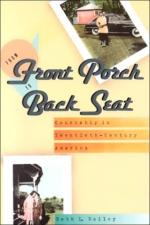
|
| Name: _________________________ | Period: ___________________ |
This test consists of 15 multiple choice questions and 5 short answer questions.
Multiple Choice Questions
1. What word from Chapter 3, "The Worth of a Date” means to make larger?
(a) Augment.
(b) Transform.
(c) Fortify.
(d) Illuminate.
2. The rules of dating were rooted in the idea of man as what, according to the author in the Introduction?
(a) Consumer.
(b) Provider.
(c) Companion.
(d) Caregiver.
3. The generational battle surrounding going steady boiled down to what, according to the author in Chapter 2, "The Economy of Dating”?
(a) Money.
(b) Politics.
(c) Religion.
(d) Sex.
4. What refers to a token indicating future marriage?
(a) Engagement ring.
(b) Dowry.
(c) Medal of honor.
(d) Letterman jacket.
5. Ideals of beauty were often set by whom, according to the author in Chapter 3, "The Worth of a Date”?
(a) Political office holders.
(b) Movie stars.
(c) Sports heroes.
(d) Returning veterans.
6. According to the author in Chapter 3, "The Worth of a Date,” American public culture since the 1920s reiterated that women should compete for men by doing what?
(a) Dancing.
(b) Consuming.
(c) Singing.
(d) Playing sports.
7. According to the author in Chapter 2, "The Economy of Dating,” dating satisfied a need in a world where few women had what?
(a) Money.
(b) Cars.
(c) Free time.
(d) Parlors.
8. What does Beth Bailey look to rather than conventions?
(a) Soap operas.
(b) Dreams.
(c) Philosophy.
(d) Experience.
9. The author states that by what decade did Americans begin to think dating was universal though it was only three decades old?
(a) The 1970s.
(b) The 1920s.
(c) The 1890s.
(d) The 1950s.
10. According to the author in the Introduction, studying the practices of the majority can have a positive impact on our understanding of what?
(a) The religious whole.
(b) The minority.
(c) Social mores as a whole.
(d) Gender identity.
11. The fact that men paid for dates was thought to imply that women owed them what, according to the author in Chapter 1, "Calling Cards and Money"?
(a) A dowry.
(b) Sexual favors.
(c) Money.
(d) Allegiance.
12. According to the author in Chapter 3, "The Worth of a Date,” simply having a date indicated what?
(a) Friendship.
(b) Experience.
(c) Failure.
(d) Success.
13. The protocol for going steady was strict and often involved what, according to the author in Chapter 2, "The Economy of Dating”?
(a) A visible token.
(b) The church’s blessing.
(c) Written vows.
(d) Life and death experiences.
14. What are shown in the book to be highly variable and responsive to changes in social attitudes and economic developments?
(a) Middle class incomes.
(b) Cultural norms.
(c) Religious attitudes.
(d) Government regulations.
15. According to the author in Chapter 3, "The Worth of a Date,” American dating emerged as what became central to courtship?
(a) Manners.
(b) Money.
(c) Looks.
(d) Social connections.
Short Answer Questions
1. According to the author in Chapter 2, "The Economy of Dating,” the transition to dating appeared as an accommodation to what?
2. According to the author in Chapter 3, "The Worth of a Date,” women and men were keen on assessing each other’s what?
3. An incredibly high rate of what appeared after World War II, according to the author in Chapter 2, "The Economy of Dating”?
4. What was Beth Bailey defending when she appeared on television during her senior year of college?
5. What constantly portrayed the other sex as commodities, according to the author in Chapter 3, "The Worth of a Date”?
|
This section contains 516 words (approx. 2 pages at 300 words per page) |

|




